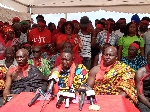Apple's 2019 MacBook Air is cheaper than before, but no game changer
Technology

Last fall, Apple updated the MacBook Air with a smaller body, sharper Retina display, larger trackpad, and added Touch ID.
It was a solid refresh after Apple neglected it for a few years to concentrate on the MacBook Pro. Good as it was, the 2018 MacBook Air fell short in a few areas: performance, keyboard, and pricing.
The 2019 MacBook Air's dual-core processor is still underpowered compared to the quad-core 13-inch MacBook Pros and other Windows laptops. However, the keyboard is improved (it's quieter and Apple says it's more reliable), the screen supports True Tone, and it starts at $1,099 instead of the previous $1,199. Apple also banished legacy ports in favor of a pair of Thunderbolt 3 USB-C ports.
If you're looking for the least expensive MacBook and don't need the performance of the 13-inch MacBook Pro, the 2019 MacBook Air is a competent laptop for light computing like writing, web browsing, and watching videos. Just don't expect it to be a champ at heavy-lifting tasks like video editing or gaming.
The biggest concern, of course, is whether you trust the keyboard to not break down. I haven't used the new MacBook Air long enough for its keyboard to exhibit repeat or failed key presses. If you do have future problems, at least Apple's got it covered under its keyboard repair program.
Yep, it's a MacBook Air
Apple changed laptops forever after Steve Jobs famously pulled the original MacBook Air out of a manila envelope to highlight how thin and light it was.
Almost overnight, laptops went from being clunky clamshells to svelte DVD drive-free wedge-shaped mobile machines with sleek, tapered frames.
The 2019 MacBook Air retains the same sturdy aluminum wedge design as its predecessor and comes in the same finishes (silver, space gray, and gold). My review unit came in gold, but it's more of a light rose-copper color if you ask me.
Apple made zero tweaks to the MacBook Air's exterior. The metal body's as dense and durable before — no flex whatsoever, which is great.
On the left of the Air, there's two Thunderbolt 3 USB-C ports, and on the right side a single 3.5mm headphone jack. I still miss the SD card slot on the pre-Retina MacBook Air dearly and hope Apple brings it back in future MacBooks.
Better display with True Tone
The Retina display is the same 13.3-inch (diagonal) size with 2,560 x 1,600 resolution at 227 pixels per inch (PPI).
When we reviewed the 2018 MacBook Air, former Mashable Tech Editor Pete Pachal said he was disappointed with the display's brightness when compared to a 13-inch MacBook Pro. Technical breakdowns revealed the MacBook Air peaked at 300 nits of brightness versus 500 nits on the 13-inch MacBook Pro. Not only did the lower brightness make content look less vibrant, but blacks were more washed out.
I'm happy to say the screen on the new MacBook Air is brighter. In April, Apple released an update that increased the 2018 MacBook Air's brightness from 300 nits to 400 nits, which is also where the 2019 model tops out.
The display still isn't as bright as the one on the MacBook Pro, but I don't think many people will be bothered by it. I usually have my laptop's brightness set to around 60-75 percent and as far as I can tell, the MacBook Air's 400-nit brightness is fine.
New for the display is True Tone. MacBook Pros, iPhones, and iPads have the feature, which adjusts the color temperature on the screen based on the lighting around you.
In layman's terms, the MacBook Air's screen is never too cool (blue) because True Tone is constantly looking at the ambient lighting and adjusting itself to match accordingly. True Tone is subtle, but it makes the screen less harsh to look at — important if you're staring at it all day.
Keyboard is fine (so far)
As I said earlier, I've never had problems with the butterfly keyboards on my personal and work MacBooks. That said, I've always disliked one thing about them: they're loud to type on.
I love me a good clackety-clack mechanical keyboard for desktop computers. But on a laptop, I prefer a quieter typing experience mainly because it's annoying to be so noisy at a coffee shop or during a conference call. Nobody wants to hear me typing.
The MacBook Air keyboard is noticeably quieter than any MacBook Pro keyboard released between 2016 to July 2018 — and nowhere as clackety as the 2017 13-inch MacBook Pro I'm using daily to run the macOS Catalina beta.
All of Apple's MacBooks now sport the improved third-generation butterfly keyboard first introduced on the MacBook Pros in May. These "3.5-generation" butterfly keyboards are quieter than previous keyboards and are supposedly made of an unspecified new material for better reliability.
The MacBook Air keyboard is not silent, but the silicone membrane below each key definitely helps to dampen keystrokes, while simultaneously adding just a teensy bit more key travel. Typing on the keyboard is not as nice as typing on a Magic Keyboard or any MacBook Pro with scissor-style keys, but I think Apple's inching closer towards a more acceptable middle ground.
Aside from the quieter keys, I love — love — that there's a row of real function keys instead of a Touch Bar, and Touch ID is integrated into the power button.
Like the butterfly keyboard or 3D Touch (bless Apple for trying to make it a thing), the Touch Bar is almost universally disliked by everyone I know. Apple has not made a strong case for why the Touch Bar is better than the function keys. And no, emoji input is not the game-changing use-case we all thought it would be.
Using the MacBook Air's function keys only reinforced how lame the Touch Bar is. The function keys just work great — one tap to adjust display brightness, keyboard backlight, volume, playback, Exposé, and Launchpad. No tapping on a skinny little arrow to expand the controls like you have to on a Touch Bar and no need to waste time with sliders to adjust brightness and volume.
That it's possible to have function keys and Touch ID without the Touch Bar is proof the MacBook Pro doesn't need it. Logging into the MacBook Air with Touch ID is faster, more convenient, and more secure than entering a password.
Time will tell how reliable the keyboard is. Again, don't forget Apple will repair busted keyboards for free.
Good-enough performance
There's a reason I'm talking about performance last: it's just enough, but not blistering fast.
The new MacBook Air is powered by a 1.6GHz dual-core 8th-generation Intel Core i5 (Y-series) processor with Turbo Boost up to 3.6GHz and Intel UHD Graphics 617 and a base of 8GB of RAM and 128GB of SSD storage. These are the same specs as the 2018 MacBook Air, which means it should perform more or less the same.
Running Geekbench 4, however, revealed a different story. Based on an average of three consecutive tests, the 2019 MacBook Air scored 4,113 on on single-core and 7,775 on multi-core, which works out to 10.5 and 15 percent faster performance, respectively, compared to the 2018 MacBook Air.
In our 2018 MacBook review, we noted how the laptop would bottleneck when pushed too hard. I ran the same workflow we did then: Slack, Trello, TweetDeck, Skype, Apple apps (Calendar, Reminders, Apple News, Messages, and Maps, and two Chrome profiles running 2-4 windows, each with about 12 tabs on average, and Amazon Music streaming in the background.
I checked to see if the fan kicked in about an hour into running so many apps and tasks and whether there was any lag in TweetDeck. Nada. I restarted and tried again, but didn't experience the same problems our former editor did.
This performance improvement could have been the result of any number of factors, including but not limited to new software updates for macOS Mojave and better optimization for third-party apps such as Chrome and TweetDeck.
But as we also noted in our previous MacBook Air review, we don't expect many people to stress their laptops this way. For general web browsing, light photo editing, writing, watching videos, and editing documents, the MacBook Air powers through like a champ. Even light video editing in iMovie won't choke the laptop to the point it's unusable.
Still, I wish Apple gave the MacBook Air a performance upgrade with a faster processor and better graphics. It's all the more disappointing when Windows laptops in the Air's price range have beefier performance.
Battery life is also so-so like before. I got between 5-7 hours of battery life while using the MacBook Air at work, but less at home when I was pushing it harder with more tasks. The battery life isn't bad, but it makes me miss the old pre-Retina Air which was a battery champ and consistently lasted between 6-7 hours.
I should also note that the MacBook Air's SSD storage reportedly has slower read and write speeds compared to the 2018 model. Though some tech blogs are being alarmist about it, let me dismiss any concerns. In reality, the laptop's reading and writing data at a second or less than before. Will you notice the difference for small file transfers? Doubtful. You might, however, notice while transferring large amounts of data, when seconds add up to minutes.
Cheaper than before
The pre-Retina MacBook Air was arguably the GOAT (greatest of all time) of laptops. It was a no-brainer to recommend that laptop to almost any non-professional.
We had high hopes the 2018 MacBook Air would carry the torch. But it was clear that refreshing the MacBook Air with a smaller body and Retina display came with some not-so-welcome compromises.
The 2019 MacBook Air is for sure better — improved keyboard, True Tone display, and faster performance despite same specs — but perhaps more important is that it starts at $1,099 instead of the previous $1,199.
A hundred bucks might not seem like a lot. But to many shoppers, being closer to $1,000 makes it seem like a much better value. The 2019 MacBook Air is not quite as affordable as the pre-Retina MacBook Air, which started at $999, but it's getting there.
For students, the MacBook Air is a good laptop and affordable ($999 with an education discount). The Windows laptop world still looks really tempting, though. Microsoft's Surface Laptop 2 — our favorite laptop last year — starts at $999 (though it's regularly discounted to $899) and comes with more powerful quad-core performance, a touchscreen, and a full-sized USB-A port (no dongles necessary). Ditto for other laptops like the Huawei MateBook 13 (starting at $999) and Dell XPS 13 (starting at $1,199.99 but can easily be found for $999.99).
Unless you need the horsepower (then get a MacBook Pro), the MacBook Air does the job. It's not knock-your-socks off incredible like the pre-Retina MacBook Air was, but it's fine. Hopefully the next update will be more exciting.
Source: Mashable
It was a solid refresh after Apple neglected it for a few years to concentrate on the MacBook Pro. Good as it was, the 2018 MacBook Air fell short in a few areas: performance, keyboard, and pricing.
The 2019 MacBook Air's dual-core processor is still underpowered compared to the quad-core 13-inch MacBook Pros and other Windows laptops. However, the keyboard is improved (it's quieter and Apple says it's more reliable), the screen supports True Tone, and it starts at $1,099 instead of the previous $1,199. Apple also banished legacy ports in favor of a pair of Thunderbolt 3 USB-C ports.
If you're looking for the least expensive MacBook and don't need the performance of the 13-inch MacBook Pro, the 2019 MacBook Air is a competent laptop for light computing like writing, web browsing, and watching videos. Just don't expect it to be a champ at heavy-lifting tasks like video editing or gaming.
The biggest concern, of course, is whether you trust the keyboard to not break down. I haven't used the new MacBook Air long enough for its keyboard to exhibit repeat or failed key presses. If you do have future problems, at least Apple's got it covered under its keyboard repair program.
Yep, it's a MacBook Air
Apple changed laptops forever after Steve Jobs famously pulled the original MacBook Air out of a manila envelope to highlight how thin and light it was.
Almost overnight, laptops went from being clunky clamshells to svelte DVD drive-free wedge-shaped mobile machines with sleek, tapered frames.
The 2019 MacBook Air retains the same sturdy aluminum wedge design as its predecessor and comes in the same finishes (silver, space gray, and gold). My review unit came in gold, but it's more of a light rose-copper color if you ask me.
Apple made zero tweaks to the MacBook Air's exterior. The metal body's as dense and durable before — no flex whatsoever, which is great.
On the left of the Air, there's two Thunderbolt 3 USB-C ports, and on the right side a single 3.5mm headphone jack. I still miss the SD card slot on the pre-Retina MacBook Air dearly and hope Apple brings it back in future MacBooks.
Better display with True Tone
The Retina display is the same 13.3-inch (diagonal) size with 2,560 x 1,600 resolution at 227 pixels per inch (PPI).
When we reviewed the 2018 MacBook Air, former Mashable Tech Editor Pete Pachal said he was disappointed with the display's brightness when compared to a 13-inch MacBook Pro. Technical breakdowns revealed the MacBook Air peaked at 300 nits of brightness versus 500 nits on the 13-inch MacBook Pro. Not only did the lower brightness make content look less vibrant, but blacks were more washed out.
I'm happy to say the screen on the new MacBook Air is brighter. In April, Apple released an update that increased the 2018 MacBook Air's brightness from 300 nits to 400 nits, which is also where the 2019 model tops out.
The display still isn't as bright as the one on the MacBook Pro, but I don't think many people will be bothered by it. I usually have my laptop's brightness set to around 60-75 percent and as far as I can tell, the MacBook Air's 400-nit brightness is fine.
New for the display is True Tone. MacBook Pros, iPhones, and iPads have the feature, which adjusts the color temperature on the screen based on the lighting around you.
In layman's terms, the MacBook Air's screen is never too cool (blue) because True Tone is constantly looking at the ambient lighting and adjusting itself to match accordingly. True Tone is subtle, but it makes the screen less harsh to look at — important if you're staring at it all day.
Keyboard is fine (so far)
As I said earlier, I've never had problems with the butterfly keyboards on my personal and work MacBooks. That said, I've always disliked one thing about them: they're loud to type on.
I love me a good clackety-clack mechanical keyboard for desktop computers. But on a laptop, I prefer a quieter typing experience mainly because it's annoying to be so noisy at a coffee shop or during a conference call. Nobody wants to hear me typing.
The MacBook Air keyboard is noticeably quieter than any MacBook Pro keyboard released between 2016 to July 2018 — and nowhere as clackety as the 2017 13-inch MacBook Pro I'm using daily to run the macOS Catalina beta.
All of Apple's MacBooks now sport the improved third-generation butterfly keyboard first introduced on the MacBook Pros in May. These "3.5-generation" butterfly keyboards are quieter than previous keyboards and are supposedly made of an unspecified new material for better reliability.
The MacBook Air keyboard is not silent, but the silicone membrane below each key definitely helps to dampen keystrokes, while simultaneously adding just a teensy bit more key travel. Typing on the keyboard is not as nice as typing on a Magic Keyboard or any MacBook Pro with scissor-style keys, but I think Apple's inching closer towards a more acceptable middle ground.
Aside from the quieter keys, I love — love — that there's a row of real function keys instead of a Touch Bar, and Touch ID is integrated into the power button.
Like the butterfly keyboard or 3D Touch (bless Apple for trying to make it a thing), the Touch Bar is almost universally disliked by everyone I know. Apple has not made a strong case for why the Touch Bar is better than the function keys. And no, emoji input is not the game-changing use-case we all thought it would be.
Using the MacBook Air's function keys only reinforced how lame the Touch Bar is. The function keys just work great — one tap to adjust display brightness, keyboard backlight, volume, playback, Exposé, and Launchpad. No tapping on a skinny little arrow to expand the controls like you have to on a Touch Bar and no need to waste time with sliders to adjust brightness and volume.
That it's possible to have function keys and Touch ID without the Touch Bar is proof the MacBook Pro doesn't need it. Logging into the MacBook Air with Touch ID is faster, more convenient, and more secure than entering a password.
Time will tell how reliable the keyboard is. Again, don't forget Apple will repair busted keyboards for free.
Good-enough performance
There's a reason I'm talking about performance last: it's just enough, but not blistering fast.
The new MacBook Air is powered by a 1.6GHz dual-core 8th-generation Intel Core i5 (Y-series) processor with Turbo Boost up to 3.6GHz and Intel UHD Graphics 617 and a base of 8GB of RAM and 128GB of SSD storage. These are the same specs as the 2018 MacBook Air, which means it should perform more or less the same.
Running Geekbench 4, however, revealed a different story. Based on an average of three consecutive tests, the 2019 MacBook Air scored 4,113 on on single-core and 7,775 on multi-core, which works out to 10.5 and 15 percent faster performance, respectively, compared to the 2018 MacBook Air.
In our 2018 MacBook review, we noted how the laptop would bottleneck when pushed too hard. I ran the same workflow we did then: Slack, Trello, TweetDeck, Skype, Apple apps (Calendar, Reminders, Apple News, Messages, and Maps, and two Chrome profiles running 2-4 windows, each with about 12 tabs on average, and Amazon Music streaming in the background.
I checked to see if the fan kicked in about an hour into running so many apps and tasks and whether there was any lag in TweetDeck. Nada. I restarted and tried again, but didn't experience the same problems our former editor did.
This performance improvement could have been the result of any number of factors, including but not limited to new software updates for macOS Mojave and better optimization for third-party apps such as Chrome and TweetDeck.
But as we also noted in our previous MacBook Air review, we don't expect many people to stress their laptops this way. For general web browsing, light photo editing, writing, watching videos, and editing documents, the MacBook Air powers through like a champ. Even light video editing in iMovie won't choke the laptop to the point it's unusable.
Still, I wish Apple gave the MacBook Air a performance upgrade with a faster processor and better graphics. It's all the more disappointing when Windows laptops in the Air's price range have beefier performance.
Battery life is also so-so like before. I got between 5-7 hours of battery life while using the MacBook Air at work, but less at home when I was pushing it harder with more tasks. The battery life isn't bad, but it makes me miss the old pre-Retina Air which was a battery champ and consistently lasted between 6-7 hours.
I should also note that the MacBook Air's SSD storage reportedly has slower read and write speeds compared to the 2018 model. Though some tech blogs are being alarmist about it, let me dismiss any concerns. In reality, the laptop's reading and writing data at a second or less than before. Will you notice the difference for small file transfers? Doubtful. You might, however, notice while transferring large amounts of data, when seconds add up to minutes.
Cheaper than before
The pre-Retina MacBook Air was arguably the GOAT (greatest of all time) of laptops. It was a no-brainer to recommend that laptop to almost any non-professional.
We had high hopes the 2018 MacBook Air would carry the torch. But it was clear that refreshing the MacBook Air with a smaller body and Retina display came with some not-so-welcome compromises.
The 2019 MacBook Air is for sure better — improved keyboard, True Tone display, and faster performance despite same specs — but perhaps more important is that it starts at $1,099 instead of the previous $1,199.
A hundred bucks might not seem like a lot. But to many shoppers, being closer to $1,000 makes it seem like a much better value. The 2019 MacBook Air is not quite as affordable as the pre-Retina MacBook Air, which started at $999, but it's getting there.
For students, the MacBook Air is a good laptop and affordable ($999 with an education discount). The Windows laptop world still looks really tempting, though. Microsoft's Surface Laptop 2 — our favorite laptop last year — starts at $999 (though it's regularly discounted to $899) and comes with more powerful quad-core performance, a touchscreen, and a full-sized USB-A port (no dongles necessary). Ditto for other laptops like the Huawei MateBook 13 (starting at $999) and Dell XPS 13 (starting at $1,199.99 but can easily be found for $999.99).
Unless you need the horsepower (then get a MacBook Pro), the MacBook Air does the job. It's not knock-your-socks off incredible like the pre-Retina MacBook Air was, but it's fine. Hopefully the next update will be more exciting.
Source: Mashable
Source: Emmanuel Mensah
Trending News

Adutwum campaign urges NPP to embrace change in presidential primary
05:44
GAF deploys 400 additional troops to Bawku under Operation Maidabuuri II
14:27
NPP to acclaim Akwatia by-election PC tomorrow
12:02
Tension escalates in Manso Tontokrom over planned military deployment to disputed Asanko mining site
04:55
TDC boss denies land-grabbing allegations
03:27
EC sets September 2 for Akwatia by-election following MP’s death
14:18
Dominion University to host groundbreaking media AI conference on July 31
13:15
NPP to open nominations for 2028 flagbearer race on July 29
06:03
President Mahama condemns assault of journalist by GAF personnel
03:28
Military assaults eyewitness at alleged McDan property demolition site
14:06



